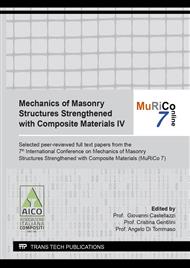[1]
Del Zoppo, M., Di Ludovico, M., & Prota, A. (2019). Analysis of FRCM and CRM parameters for the in plane shear strengthening of different URM types. Composites Part B: Engineering, 171, 20-33.
DOI: 10.1016/j.compositesb.2019.04.020
Google Scholar
[2]
De Felice, G., D'Antino, T., De Santis, S., Meriggi, P., & Roscini, F. (2020). Lessons learned on the tensile and bond behavior of fabric reinforced cementitious matrix (FRCM) composites. Frontiers in Built Environment, 6, 5.
DOI: 10.3389/fbuil.2020.00005
Google Scholar
[3]
De Felice, G., Aiello, M. A., Caggegi, C., Ceroni, F., De Santis, S., Garbin, E., ... & Viskovic, A. (2018). Recommendation of RILEM Technical Committee 250-CSM: Test method for Textile Reinforced Mortar to substrate bond characterization. Materials and Structures, 51(4), 1-9.
DOI: 10.1617/s11527-018-1216-x
Google Scholar
[4]
Leone, M., Aiello, M. A., Balsamo, A., Carozzi, F. G., Ceroni, F., Corradi, M., ... & Saenger, D. (2017). Glass fabric reinforced cementitious matrix: Tensile properties and bond performance on masonry substrate. Composites Part B: Engineering, 127, 196-214.
DOI: 10.1016/j.compositesb.2017.06.028
Google Scholar
[5]
Gattesco, N., & Boem, I. (2017). Characterization tests of GFRM coating as a strengthening technique for masonry buildings. Composite Structures, 165, 209-222.
DOI: 10.1016/j.compstruct.2017.01.043
Google Scholar
[6]
Zhu, M., Zhu, J. H., Ueda, T., Matsumoto, K., & Su, M. (2021). Bond behavior of carbon fabric reinforced cementitious matrix (FRCM) composites considering matrix impregnation. Composite Structures, 262, 113350.
DOI: 10.1016/j.compstruct.2020.113350
Google Scholar
[7]
Zhu, M., Zhu, J. H., Ueda, T., Su, M., & Xing, F. (2020). A method for evaluating the bond behavior and anchorage length of embedded carbon yarn in the cementitious matrix. Construction and Building Materials, 255, 119067.
DOI: 10.1016/j.conbuildmat.2020.119067
Google Scholar
[8]
Focacci, F., D'Antino, T., & Carloni, C. (2020). The role of the fiber–matrix interfacial properties on the tensile behavior of FRCM coupons. Construction and Building Materials, 265, 120263.
DOI: 10.1016/j.conbuildmat.2020.120263
Google Scholar
[9]
Consiglio Superiore dei Lavori Pubblici. Servizio Tecnico Centrale. Linea Guida per la identificazione, la qualificazione ed il controllo di accettazione di compositi fibrorinforzati a matrice inorganica (FRCM) da utilizzarsi per il consolidamento strutturale di costruzioni esistenti,.
DOI: 10.3221/igf-esis.12.04
Google Scholar
[10]
UNI EN 2561:1995. Serie aerospaziale. Materie plastiche rinforzate con fibre di carbonio. Laminati unidirezionali. Prova di trazione parallelamente alla direzione delle fibre.
Google Scholar
[11]
Leone, M., Rizzo, V., Micelli, F., & Aiello, M. A. (2017). Experimental Analysis on Bond Behavior of GFRCM Applied on Clay Brick Masonry. In Key Engineering Materials (Vol. 747, pp.542-549). Trans Tech Publications Ltd.
DOI: 10.4028/www.scientific.net/kem.747.542
Google Scholar
[12]
Carozzi, F. G., Bellini, A., D'Antino, T., de Felice, G., Focacci, F., Hojdys, Ł., ... & Poggi, C. (2017). Experimental investigation of tensile and bond properties of Carbon-FRCM composites for strengthening masonry elements. Composites Part B: Engineering, 128, 100-119.
DOI: 10.1016/j.compositesb.2017.06.018
Google Scholar
[13]
UNI EN 1015-11:2019. Metodi di prova per malte per opere murarie - Parte 11: Determinazione della resistenza a flessione e a compressione della malta indurita.
Google Scholar
[14]
Caggiano, A., & Martinelli, E. (2012). A unified formulation for simulating the bond behaviour of fibres in cementitious materials. Materials & Design, 42, 204-213.
DOI: 10.1016/j.matdes.2012.05.003
Google Scholar
[15]
Zhang, X. B., Aljewifi, H., & Li, J. (2014). Failure mechanism investigation of continuous fibre reinforced cementitious composites by pull-out behaviour analysis. Procedia materials science, 3, 1377-1382.
DOI: 10.1016/j.mspro.2014.06.222
Google Scholar
[16]
Lorenz, E., & Ortlepp, R. (2012). Bond behavior of textile reinforcements-development of a pull-out test and modeling of the respective bond versus slip relation. In High Performance Fiber Reinforced Cement Composites 6 (pp.479-486). Springer, Dordrecht.
DOI: 10.1007/978-94-007-2436-5_58
Google Scholar


